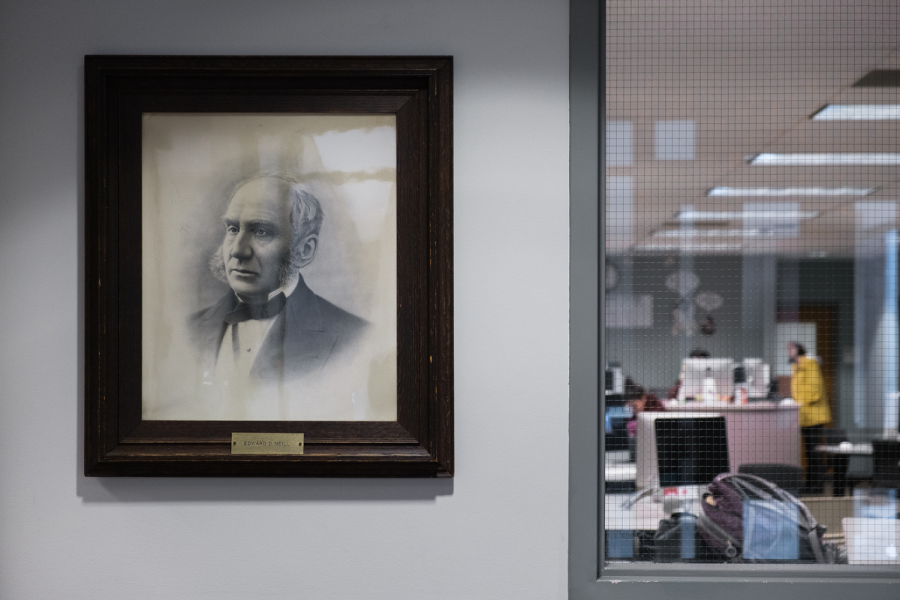Who was Edward Duffield Neill?
October 31, 2019
Edward Duffield Neill, the founder and first president of Macalester College, was a white supremacist and eager participant in the settler-colonization of Minnesota.
Neill moved to St. Paul in 1849 as a 26-year-old Presbyterian missionary. Born and raised in Philadelphia, he spent time living in Illinois before heading further west to St. Paul. In a letter sent to the Rev. Milton Badger D.D. in 1850, he described his new home as “a village of 300 inhabitants, mostly illiterate French Canadians attached to the Church of Rome.”
Shortly after arriving, Neill began his life’s work: creating churches and educational institutions.
According to a biography of Neill written by former Macalester President J. Huntley Dupre, Neill’s educational qualifications from his time at Amherst College, the University of Pennsylvania and Andover Seminary helped him get involved in local government.
Once in local government, he became friends with some of the most influential white men in Minnesota — people like Alexander Ramsey and William Marshall who would go on to become not only future governors of the state of Minnesota, but also early supporters of Macalester.
Neill delivered the invocation at the first sitting of Minnesota’s territorial legislature in 1849, wrote mission statements for St. Paul’s first public schools and helped found the Minnesota Historical Society.
The schools and churches he created included the first Presbyterian Church in Minnesota, and, in 1853, the Baldwin School — the prep school precursor to Macalester.
In going about his work, he actively participated in, supported and legitimized the white settler-colonization of Minnesota.
As an amateur historian and archaeologist, Neill participated in some of those fields’ worst practices — such as desecrating and stealing from the graves of indigenous people, which he did at Mound 9 of St. Paul’s Mounds Park in 1856.
He wrote prolifically about the history of white settler-colonization not only in the Midwest, but across the present-day United States of America. These writings most clearly reveal his white supremacism.
In his “History of Freeborn County,” Neill wrote that, “The white race, some two hundred years ago, had entered upon the material conquest of the American continent… came in contact with a race of savages with many of the traits peculiar to a common humanity, yet, with these, exhibiting all, or nearly all, the vices of the most barbarous savage races.”
Later in the same passage, he wrote, “The white man was at once acknowledged, the Indian being judge, superior to the savage race with which he had come in contact… The inferior race must either recede before the superior, or sink into the common mass, and, like the raindrops falling upon the bosom of the ocean, lose all traces of distinction.”
Neill formally addressed what he saw as the “effort and failure to civilize the aborigines” in an 1868 letter to the Commissioner of Indian Affairs Hon. N.G. Taylor, in which he went a step further and advocated concrete proposals for forced assimilation like regulation of the dress and religious practice of indigenous peoples.
Neill also advocated a policy known as allotment, which called for the division of communally owned indigenous lands into private plots — a practice that the U.S. government ultimately adopted more than a decade later.
The General Allotment Act of 1887 allowed the U.S. government to steal 60 million acres for homesteading by non-indigenous settlers and corporations.
In 1887, according to the Indian Land Tenure Foundation, indigenous land holdings numbered 138 million acres across the country. By 1934, that number had fallen to 48 million acres.
When Neill wrote to Taylor, he was not living in Minnesota, since he left in 1861. During the Civil War, Ramsey helped him obtain a military chaplaincy in Philadelphia. Neill then secured a promotion to serve as President Abraham Lincoln’s private secretary in 1864.
While Neill was in Philadelphia and the Civil War raged across the South, the United States fought another war: the U.S.-Dakota War, which took place in Minnesota.
After heightening tensions caused by the seizure of Dakota land and the United States’ refusal to pay the Dakota their treaty annuities, war broke out in August 1862. Over the next six weeks, thousands died during the conflict before the United States eventually prevailed.
Neill wrote about the war extensively in his 1883 book, “The History of Minnesota: From the Earliest French Explorations to the Present Time,” deploying racist tropes to describe the Dakota peoples’ alleged physical and sexual violence during the war.
In describing the first large-scale violent act of the war, a Dakota attack on white settlers living on the Lower Sioux Agency, Neill wrote that “the fiends of hell could not invent more fearful atrocities than were perpetrated by the savages upon their victims. The bullet, the tomahawk and the scalping-knife spared neither age nor sex, the only prisoners taken being the young and comely women, to minister to the brutal lusts of their captors, and a few children.”
He invoked the same physically and sexually violent tropes several pages later, when describing the return of white and mixed-race captives at the end of the war.
According to “Nature and Revelation,” a history of Macalester College written by Jeanne Halgren Kilde, Ramsey tried to get Neill a job as head of the Freedman’s Bureau after the war. Although he was unsuccessful, Neill went on to serve as U.S. Consul in Dublin before returning to Minnesota in 1871 — at which point he redoubled his efforts to start a college.
He was finally successful when, three years later, Macalester College officially opened its doors.
Neill worked at the college for the rest of his life, first as its president and then as a professor. Late in his time at Macalester, Neill took another stand: adamantly opposing the co-education of the college.
According to “Nature and Revelation,” in 1885 when the prep school co-educated, he refused to teach any classes with women in them.
He made his opposition to co-education clear when giving the dedicatory address at the opening of Macalester’s new — and modern-day — campus, saying that “whenever an institution of learning becomes anxious for a long catalogue of students, there is danger to its catering to the popular taste, and lowering the standard of scholarship.”
When Macalester formally co-educated in 1893 over his vocal protestations, Neill went on strike. After weeks, then-college President Adam Ringland visited Neill’s home in the hope of convincing him to return.
That afternoon, Neill died of a heart attack.
The closest Macalester gets to telling an official, public history of Neill is his brief biography on the Founders Day web page. The resolution changing the name of the Humanities Building to Neill Hall in 2013 also included biographical details.
Neither document refers to anything he said or wrote about indigenous people or his adamant opposition to co-education.
This article is part of the Mac Weekly’s special reporting project, Colonial Macalester. Read the entire issue here.













Walt Mills • Nov 19, 2019 at 9:23 am
OK kids here’s the situation. The Dakota conflict was a real bitch. Upwards of 800 white settlers were murdered in their homes, farms, and towns. The Dakota who attacked them lost less than 100 men in the raids. Yes they were being shorted on their rations and who would not be upset by that, but killing 800 people and forcing another 20,000 to flee for their lives? The Dakota men who got hung, had blood on their hands. They were not the innocents.
Calling their assault, an attack on white supremacy, or something like that really a stretch. The reason the kill ratio was so out of proportion, had a lot to do with the Civll War, engulfing the country at that time. The Minnesota men, who could have been home, defending their families were in the Union Army, fighting the Southern Slavocracy. That is how racist Minnesotans were in that era. The Civil War, in 1862, has nearly caused our Federal government to collapse. This is why the Dakota, did not get their rations, as much as anything. Our government was faltering, badly at that time. Neill, served in the Union Army. His attitudes were formed from that period. If you feel your attitudes are superior to people of that era, well good for you.
U of Mn. grad. Sometime in the 70’s
Michael Skoien • Nov 2, 2019 at 9:37 pm
While it is disheartening to learn of Mr Neil’s beliefs and actions towards indigenous peoples, particularly in Minnesota, I do not see the need or purpose of his opposition to co-education to tell your story. That Macalester became coed in the late 19th century is a major accomplishment. That Neill objected is most likely in line with the beliefs of most institutions of higher learning. Major examples being the Ivy League schools which all but Cornell did not become coed until the 70s-80s, similar to Georgetown, Norte Dame and locally, St. John’s and St. Thomas. Adding his opposition to coeducation, seems unnecessary piling on to the more obvious and egregious beliefs and actions of Mr. Neill. And not really germane to this series, in my opinion. Michael Skoien ‘73